Effect of Various Fly Ash and Ground Granulated Blast Furnace Slag Content on Concrete Properties: Experiments and Modelling
Abstract
:1. Introduction
2. Materials and Methods
2.1. Materials and Mix Proportion
2.2. Mechanical Properties Investigation
2.3. Autogenous Shrinkage Measurement
3. Results and Discussion
3.1. Mechanical Properties of Concrete
3.2. Autogenous Shrinkage of Concrete
4. Assessment of Models Predicting Mechanical Properties and Autogenous Shrinkage of Concrete
4.1. Mechanical Properties of Concrete
4.2. Autogenous Shrinkage of Concrete
5. Modelling Development of Mechanical Properties of Concrete with Fly Ash and GGBFS
5.1. Proposed Model
5.2. Proposed Model Comparison with Experimental Results
6. Conclusions
- Fly ash and GGBFS reduced the early age mechanical properties of concrete, but the compressive strength and splitting tensile strength of fly ash concrete were similar to OPC concrete at 28 days, while GGBFS increased the compressive strength of concrete at 28 days. Both fly ash and GGBFS decreased the flexural strength and elastic modulus of concrete. When ternary binders were incorporated, the concrete also exhibited low mechanical properties.
- The model in existing standards overestimated the early age of compressive strength development but underestimated the splitting tensile strength of concrete, leading to an unreliable calculation for design purposes. As such, it is recommended to consider the effect of fly ash and GGBFS on concrete’s mechanical properties development.
- A model capturing the effect of fly ash and GGBFS on the development of compressive and splitting tensile strength was proposed. The statistical analysis of the comparison between predicted and measured compressive strength and splitting tensile strength showed a good agreement. The mean value and CoV are 1.00, 0.10, and 0.95, 0.17 for the and prediction models, respectively.
- The autogenous shrinkage of concrete mixes with fly ash and GGBFS was different from that of OPC concrete. The model in existing standards failed in predicting the early-age autogenous shrinkage development of fly ash and GGBFS concrete. As a result, a broader database of concrete containing fly ash and GGBFS values is recommended to improve and establish optimal parameters in existing models.
Author Contributions
Funding
Institutional Review Board Statement
Informed Consent Statement
Data Availability Statement
Acknowledgments
Conflicts of Interest
References
- Ramezani, M. Design and Predicting Performance of Carbon Nanotube Reinforced Cementitious Materials: Mechanical Properties and Dipersion Characteristics. Doctoral Dissertation, University of Louisville, Louisville, Kentucky, 2019. [Google Scholar] [CrossRef] [Green Version]
- Cao, Z.; Shen, L.; Liu, L.; Zhong, S. Analysis on major drivers of cement consumption during the urbanization process in China. J. Clean. Prod. 2016, 133, 304–313. [Google Scholar] [CrossRef]
- Chen, W.; Hong, J.; Xu, C. Pollutants generated by cement production in China, their impacts, and the potential for environmental improvement. J. Clean. Prod. 2015, 103, 61–69. [Google Scholar] [CrossRef]
- Ramezani, M.; Kim, Y.H.; Sun, Z. Modeling the mechanical properties of cementitious materials containing CNTs. Cem. Concr. Compos. 2019, 104, 103347. [Google Scholar] [CrossRef]
- Ramezani, M.; Kim, Y.H.; Sun, Z. Probabilistic model for flexural strength of carbon nanotube reinforced cement-based materials. Compos. Struct. 2020, 253, 112748. [Google Scholar] [CrossRef]
- Ramezani, M.; Kim, Y.H.; Sun, Z. Elastic modulus formulation of cementitious materials incorporating carbon nanotubes: Probabilistic approach. Constr. Build. Mater. 2020, 274, 122092. [Google Scholar] [CrossRef]
- Ramezani, M.; Kim, Y.; Sun, Z. Probabilistic Model for Flexural Strength of Cementitious Materials Containing CNTs. In Proceedings of the International Conference on Cement-Based Materials Tailored for A Sustainable Future, Istanbul, Turkey, 27–29 May 2021. [Google Scholar]
- Xue, Y.; Liu, X. Detoxification, solidification and recycling of municipal solid waste incineration fly ash: A review. Chem. Eng. J. 2021, 420, 130349. [Google Scholar] [CrossRef]
- Nath, S.K.; Randhawa, N.S.; Kumar, S. A review on characteristics of silico-manganese slag and its utilization into construction materials. Resour. Conserv. Recycl. 2021, 176, 105946. [Google Scholar] [CrossRef]
- Xing, Y.; Guo, F.; Xu, M.; Gui, X.; Li, H.; Li, G.; Xia, Y.; Han, H. Separation of unburned carbon from coal fly ash: A review. Powder Technol. 2019, 353, 372–384. [Google Scholar] [CrossRef]
- Zhang, J.; Zhang, S.; Liu, B. Degradation technologies and mechanisms of dioxins in municipal solid waste incineration fly ash: A review. J. Clean. Prod. 2019, 250, 119507. [Google Scholar] [CrossRef]
- Gholampour, A.; Ozbakkaloglu, T. Performance of sustainable concretes containing very high volume Class-F fly ash and ground granulated blast furnace slag. J. Clean. Prod. 2017, 162, 1407–1417. [Google Scholar] [CrossRef]
- De Maeijer, P.K.; Craeye, B.; Snellings, R.; Kazemi-Kamyab, H.; Loots, M.; Janssens, K.; Nuyts, G. Effect of ultra-fine fly ash on concrete performance and durability. Constr. Build. Mater. 2020, 263, 120493. [Google Scholar] [CrossRef]
- Moghaddam, F.; Sirivivatnanon, V.; Vessalas, K. The effect of fly ash fineness on heat of hydration, microstructure, flow and compressive strength of blended cement pastes. Case Stud. Constr. Mater. 2019, 10, e00218. [Google Scholar] [CrossRef]
- Saha, A.K. Effect of class F fly ash on the durability properties of concrete. Sustain. Environ. Res. 2018, 28, 25–31. [Google Scholar] [CrossRef]
- Moffatt, E.G.; Thomas, M.D.; Fahim, A. Performance of high-volume fly ash concrete in marine environment. Cem. Concr. Res. 2017, 102, 127–135. [Google Scholar] [CrossRef]
- Kristiawan, S.A.; Aditya, M.T.M. Effect of High Volume Fly Ash on Shrinkage of Self-compacting Concrete. Procedia Eng. 2015, 125, 705–712. [Google Scholar] [CrossRef] [Green Version]
- Neville, A. Properties of Concrete; Pearson: Harlow, UK, 2011. [Google Scholar]
- Hussain, S.; Bhunia, D.; Singh, S.B. Comparative study of accelerated carbonation of plain cement and fly-ash concrete. J. Build. Eng. 2017, 10, 26–31. [Google Scholar] [CrossRef]
- Hefni, Y.; El Zaher, Y.A.; Wahab, M.A. Influence of activation of fly ash on the mechanical properties of concrete. Constr. Build. Mater. 2018, 172, 728–734. [Google Scholar] [CrossRef]
- Sun, J.; Shen, X.; Tan, G.; Tanner, J.E. Compressive strength and hydration characteristics of high-volume fly ash concrete prepared from fly ash. J. Therm. Anal. 2018, 136, 565–580. [Google Scholar] [CrossRef]
- Özbay, E.; Erdemir, M.; Durmuş, H.I. Utilization and efficiency of ground granulated blast furnace slag on concrete properties–A review. Constr. Build. Mater. 2016, 105, 423–434. [Google Scholar] [CrossRef]
- Łukowski, P.; Salih, A. Durability of Mortars Containing Ground Granulated Blast-furnace Slag in Acid and Sulphate Environment. Procedia Eng. 2015, 108, 47–54. [Google Scholar] [CrossRef] [Green Version]
- Al-Hamrani, A.; Kucukvar, M.; Alnahhal, W.; Mahdi, E.; Onat, N. Green concrete for a circular economy: A review on sustainability, durability, and structural properties. Materials 2021, 14, 351. [Google Scholar] [CrossRef] [PubMed]
- Li, K.; Zeng, Q.; Luo, M.; Pang, X. Effect of self-desiccation on the pore structure of paste and mortar incorporating 70% GGBS. Constr. Build. Mater. 2014, 51, 329–337. [Google Scholar] [CrossRef]
- Mohan, A.; Mini, K.M. Strength and durability studies of SCC incorporating silica fume and ultra fine GGBS. Constr. Build. Mater. 2018, 171, 919–928. [Google Scholar] [CrossRef]
- El-Chabib, H.; Syed, A. Properties of Self-Consolidating Concrete Made with High Volumes of Supplementary Cementitious Materials. J. Mater. Civ. Eng. 2013, 25, 1579–1586. [Google Scholar] [CrossRef]
- Darquennes, A.; Rozière, E.; Khokhar, M.; Turcry, P.; Loukili, A.; Grondin, F. Long-term deformations and cracking risk of concrete with high content of mineral additions. Mater. Struct. 2012, 45, 1705–1716. [Google Scholar] [CrossRef]
- Zhao, Y.; Gong, J.; Zhao, S. Experimental study on shrinkage of HPC containing fly ash and ground granulated blast-furnace slag. Constr. Build. Mater. 2017, 155, 145–153. [Google Scholar] [CrossRef]
- Ramezani, M.; Kim, Y.H.; Sun, Z. Mechanical properties of carbon-nanotube-reinforced cementitious materials: Database and statistical analysis. Mag. Concr. Res. 2020, 72, 1047–1071. [Google Scholar] [CrossRef]
- EN 1992-1-1; Design of Concrete Structures Part 1-1: General Rules and Rules for Buildings. European Committee for Standardisation: Brussels, Belgium, 2004.
- FIB. FIB Model Code for Concrete Structures; Wiley-VCH Verlag GmbH & Co. KGaA: Weinheim, Germany, 2010. [Google Scholar]
- Singh, P.; Bhardwaj, S.; Dixit, S.; Shaw, R.N.; Ghosh, A. Development of Prediction Models to Determine Compressive Strength and Workability of Sustainable Concrete with ANN. In Innovations in Electrical and Electronic Engineering; Lecture Notes in Electrical Engineering; Springer: Singapore, 2021; pp. 753–769. [Google Scholar] [CrossRef]
- Bhaskara, G.S.V.; Rao, K.B.; Anoop, M.B. Model for compressive strength development of OPC concrete and fly ash concrete with time. Mag. Concr. Res. 2018, 70, 541–557. [Google Scholar] [CrossRef]
- Liu, M.H.; Wang, Y.F. Prediction of the Strength Development of Fly Ash Concrete. Adv. Mater. Res. 2010, 150–151, 1026–1033. [Google Scholar] [CrossRef]
- GB175-2020; Common Portland Cement. Quality Supervision Inspection and Quarantine of the People’s Republic of China and Standardization Administration of the People’s Republic China: Beijing, China, 2020.
- GB/T1596-2017; Fly Ash Used for Cement and Concrete. Quality Supervision Inspection and Quarantine of the People’s Republic of China and Standardization Administration of the People’s Republic China: Beijing, China, 2017.
- GB/T18046-2017; Ground Granulated Blast Furnace Slag Used for Cement, Mortar and Concrete. Quality Supervision Inspection and Quarantine of the People’s Republic of China and Standardization Administration of the People’s Republic China: Beijing, China, 2017.
- GB/T50081-2019; Standard for Test Methods of Concrete Physical and Mechanical Properties. Quality Supervision Inspection and Quarantine of the People’s Republic of China and Standardization Administration of the People’s Republic China: Beijing, China, 2019.
- Wang, X.-Y.; Park, K.-B. Analysis of compressive strength development of concrete containing high volume fly ash. Constr. Build. Mater. 2015, 98, 810–819. [Google Scholar] [CrossRef]
- Liu, Z.; Takasu, K.; Koyamada, H.; Suyama, H. A study on engineering properties and environmental impact of sustainable concrete with fly ash or GGBS. Constr. Build. Mater. 2021, 316, 125776. [Google Scholar] [CrossRef]
- Han, S.-H.; Kim, J.-K.; Park, Y.-D. Prediction of compressive strength of fly ash concrete by new apparent activation energy function. Cem. Concr. Res. 2003, 33, 965–971. [Google Scholar] [CrossRef]
- Hwang, K.; Tomosawa, F.; Noguchi, T. Prediction model of compressive strength development of fly-ash concrete. Cem. Concr. Res. 2004, 34, 2269–2276. [Google Scholar] [CrossRef]
- Ramezani, M.; Dehghani, A.; Sherif, M.M. Carbon nanotube reinforced cementitious composites: A comprehensive review. Constr. Build. Mater. 2021, 315, 125100. [Google Scholar] [CrossRef]
- Shariq, M.; Prasad, J.; Masood, A. Effect of GGBFS on time dependent compressive strength of concrete. Constr. Build. Mater. 2010, 24, 1469–1478. [Google Scholar] [CrossRef]
- Brooks, J.; Al-Kaisi, A. Early strength development of portland and slag cement concretes cured at elevated temperatures. ACI Mater. J. 1990, 87, 503–507. [Google Scholar]
- Wang, D.; Chen, Z. On predicting compressive strengths of mortars with ternary blends of cement, GGBFS and fly ash. Cem. Concr. Res. 1997, 27, 487–493. [Google Scholar] [CrossRef]
- Zhang, H.; Bai, L.; Qi, Y.; Hong, H.; Neupane, A.; Pan, Q. Impact of Splitting Tensile Properties and Dynamic Constitutive Model of Fly Ash Concrete. J. Mater. Civ. Eng. 2020, 32, 04020225. [Google Scholar] [CrossRef]
- Shen, D.; Jiao, Y.; Kang, J.; Feng, Z.; Shen, Y. Influence of ground granulated blast furnace slag on early-age cracking potential of internally cured high performance concrete. Constr. Build. Mater. 2019, 233, 117083. [Google Scholar] [CrossRef]
- Güneyisi, E.; Gesoglu, M. A study on durability properties of high-performance concretes incorporating high replacement levels of slag. Mater. Struct. 2007, 41, 479–493. [Google Scholar] [CrossRef]
- Atis, C.D.; Karahan, O.; Ari, K.; Sola, Ö.C.; Bilim, C. Relation between Strength Properties (Flexural and Compressive) and Abrasion Resistance of Fiber (Steel and Polypropylene)-Reinforced Fly Ash Concrete. J. Mater. Civ. Eng. 2009, 21, 402–408. [Google Scholar] [CrossRef]
- Nili, M.; Tadayon, M. The relationship between setting time and early age strength of concrete containing silica fume, fly ash and slag. In Proceedings of the Third International Conference on Sustainable Construction Materials and Technologies, Kyoto, Japan, 18–22 August 2013. [Google Scholar]
- Pane, I.; Hansen, W. Investigation on key properties controlling early-age stress development of blended cement concrete. Cem. Concr. Res. 2008, 38, 1325–1335. [Google Scholar] [CrossRef]
- Zhang, Y.; Afroz, S.; Nguyen, Q.D.; Kim, T.; Eisenträger, J.; Castel, A.; Xu, T. Analytical model predicting the concrete tensile stress development in the restrained shrinkage ring test. Constr. Build. Mater. 2021, 307, 124930. [Google Scholar] [CrossRef]
- Xie, L. Influence of Mineral Admixtures on Early-Age Autogenous Shrinkage of High-Performance Concrete. Appl. Mech. Mater. 2013, 457–458, 318–322. [Google Scholar] [CrossRef]
- Afroz, S.; Zhang, Y.; Nguyen, Q.D.; Kim, T.; Castel, A. Effect of limestone in General Purpose cement on autogenous shrinkage of high strength GGBFS concrete and pastes. Constr. Build. Mater. 2022, 327, 126949. [Google Scholar] [CrossRef]
- Nguyen, Q.D.; Afroz, S.; Zhang, Y.; Kim, T.; Li, W.; Castel, A. Autogenous and total shrinkage of limestone calcined clay cement (LC3) concretes. Constr. Build. Mater. 2021, 314, 125720. [Google Scholar] [CrossRef]
- AS 3600-2018; Australian Standard for Concrete Structures. Standards Australia: Sydney, Australia, 2018.
- Petrounias, P.; Rogkala, A.; Giannakopoulou, P.P.; Christogerou, A.; Lampropoulou, P.; Liogris, S.; Koutsovitis, P.; Koukouzas, N. Utilization of Industrial Ferronickel Slags as Recycled Concrete Aggregates. Appl. Sci. 2022, 12, 2231. [Google Scholar] [CrossRef]
- Faridmehr, I.; Shariq, M.; Plevris, V.; Aalimahmoody, N. Novel hybrid informational model for predicting the creep and shrinkage deflection of reinforced concrete beams containing GGBFS. Neural Comput. Appl. 2022, 31, 157–169. [Google Scholar] [CrossRef]
- Jahangir, H.; Eidgahee, D.R. A new and robust hybrid artificial bee colony algorithm—ANN model for FRP-concrete bond strength evaluation. Compos. Struct. 2020, 257, 113160. [Google Scholar] [CrossRef]
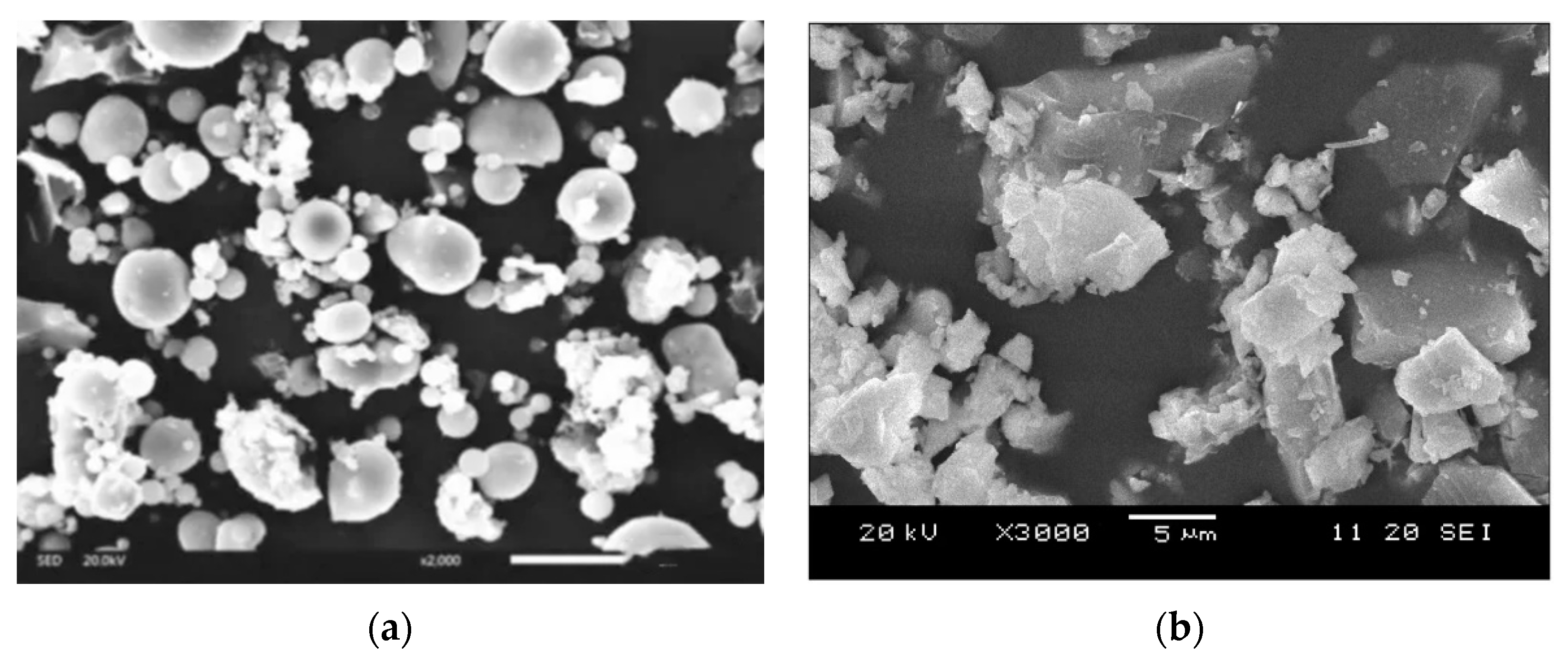
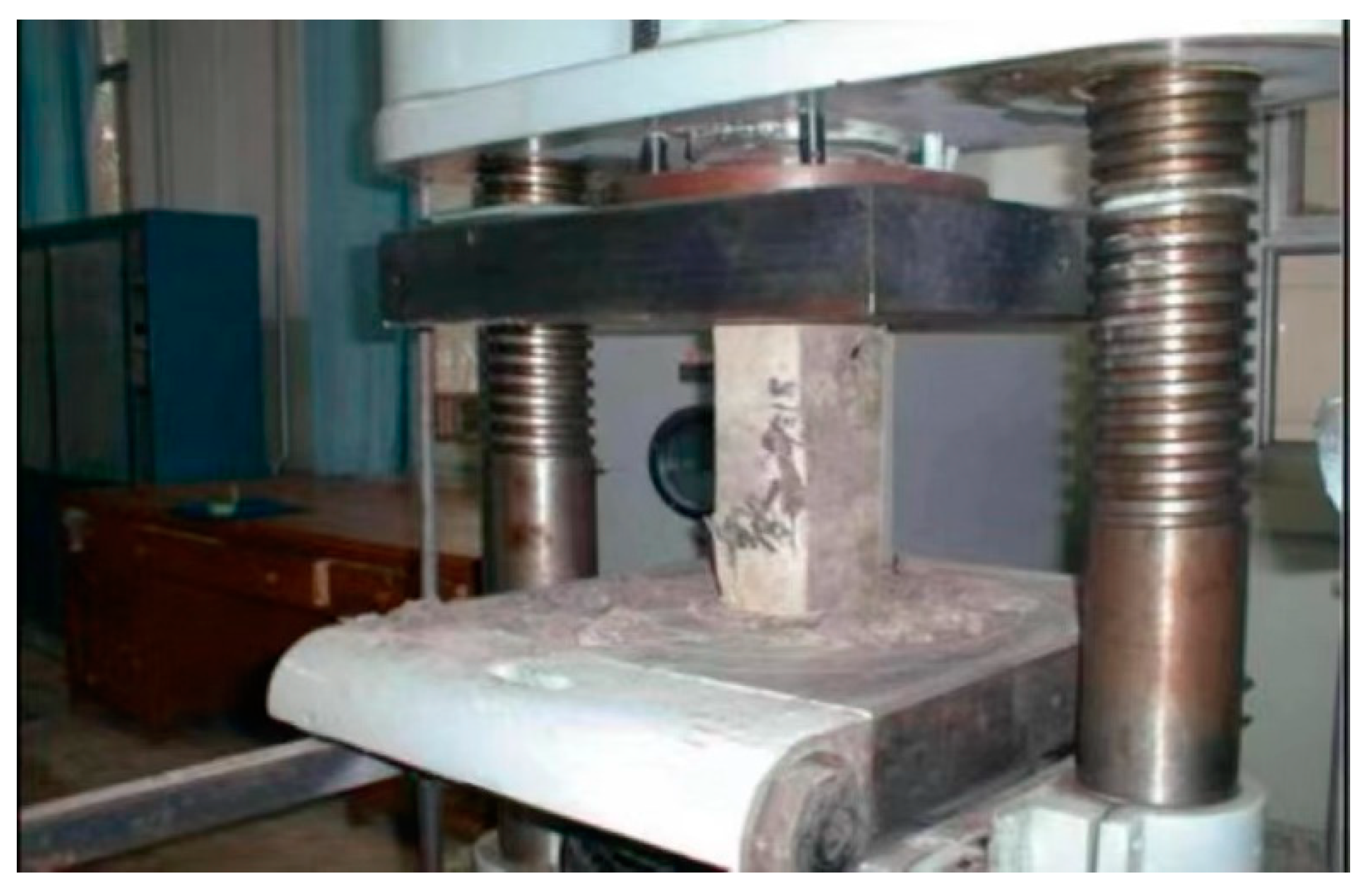

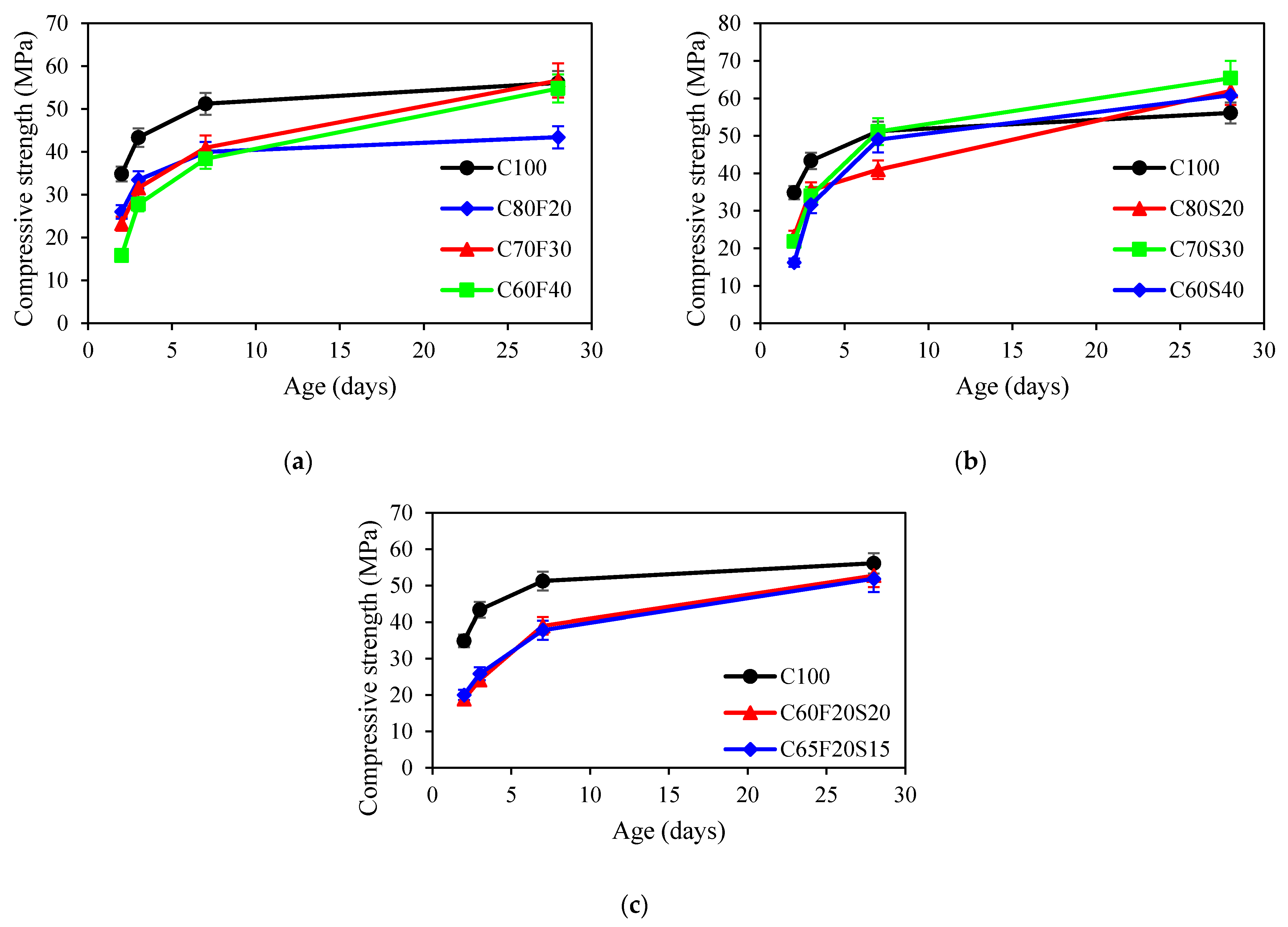
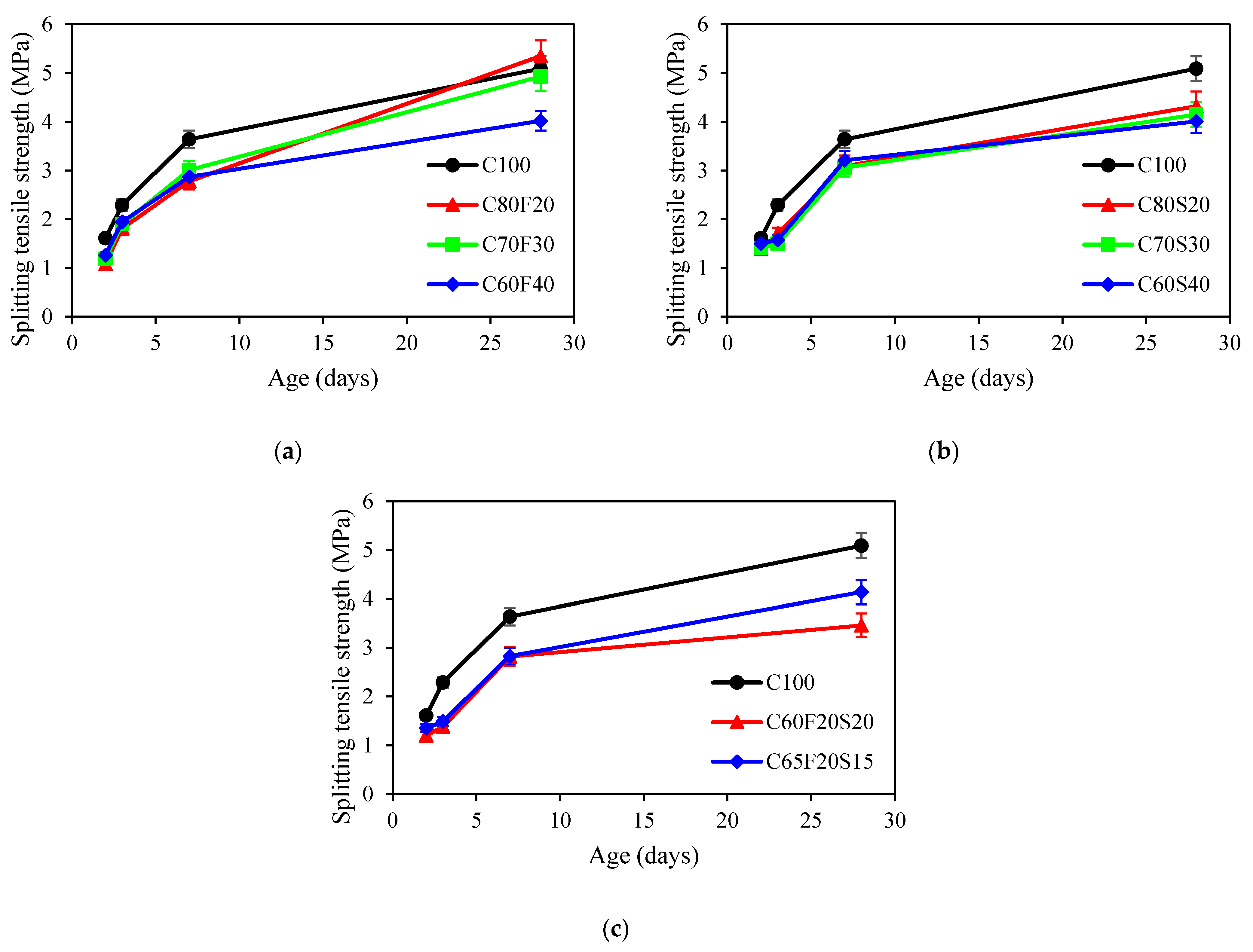
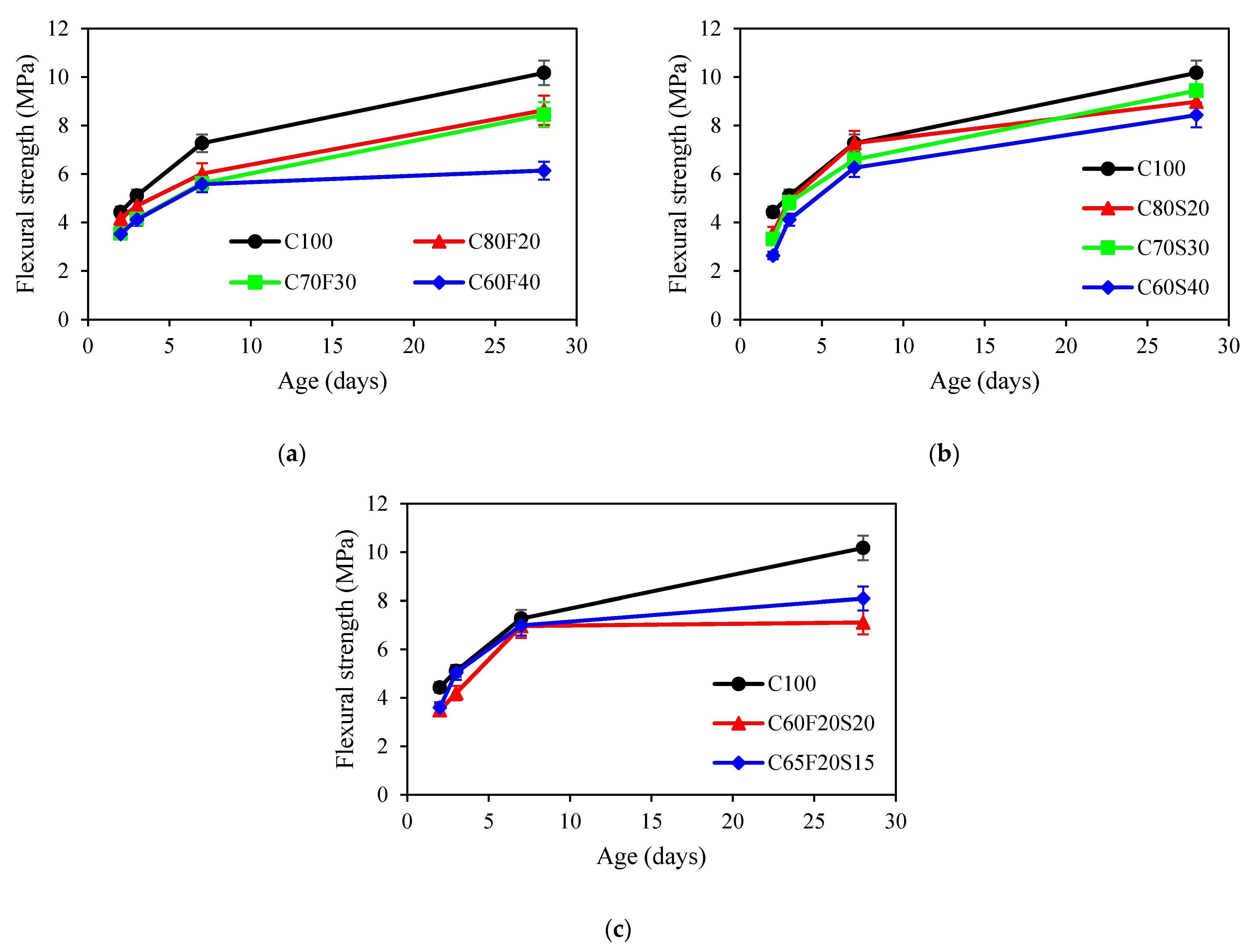

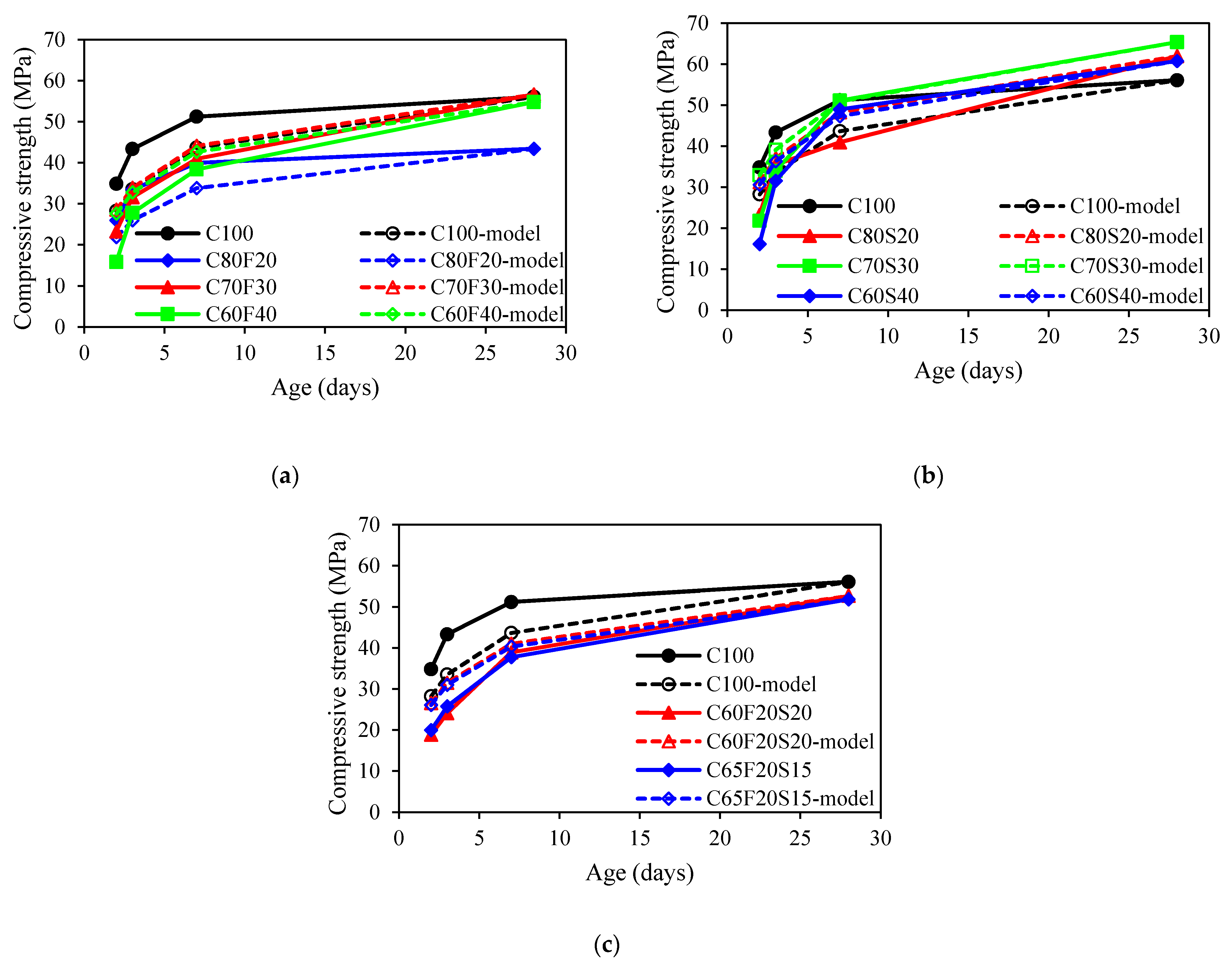
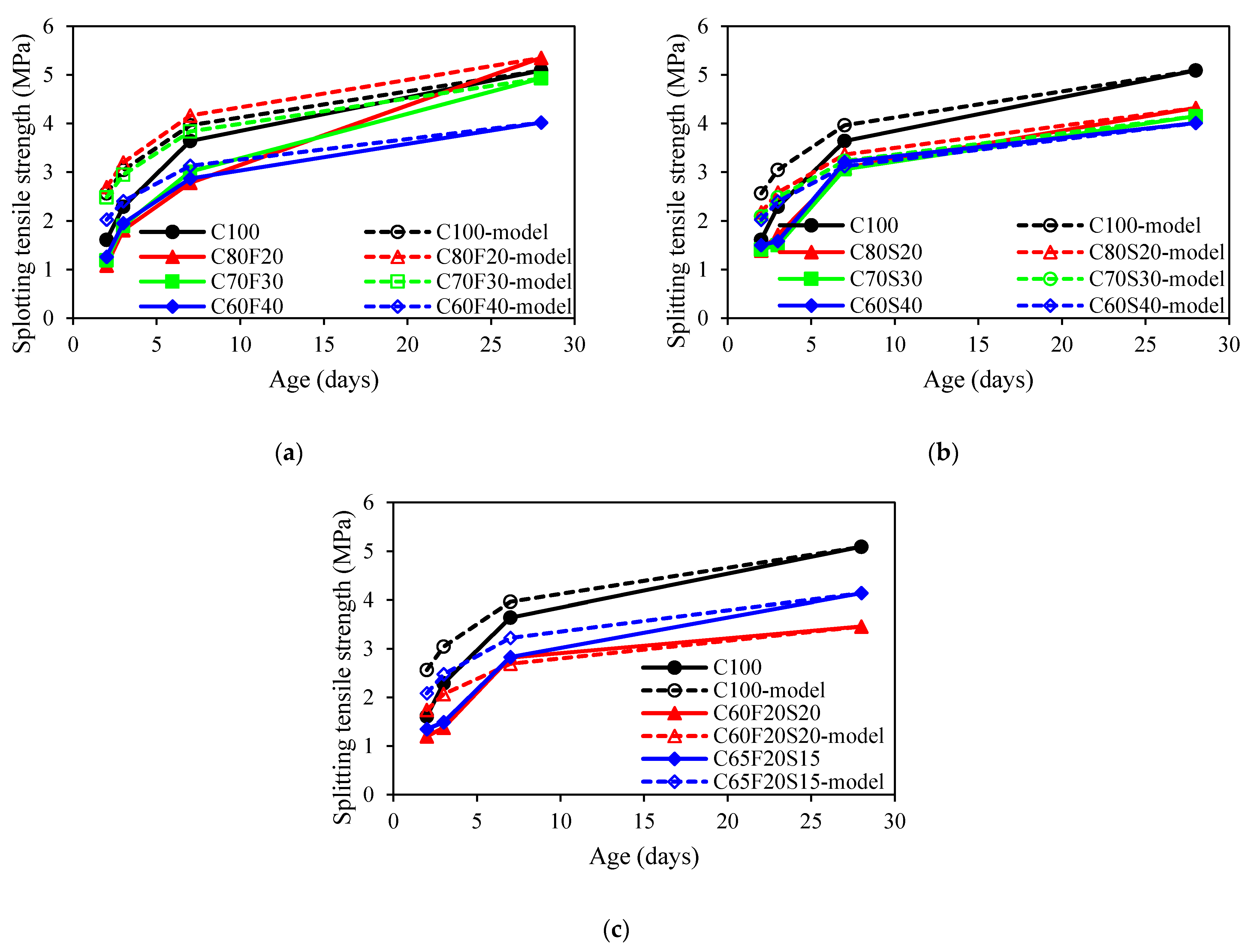



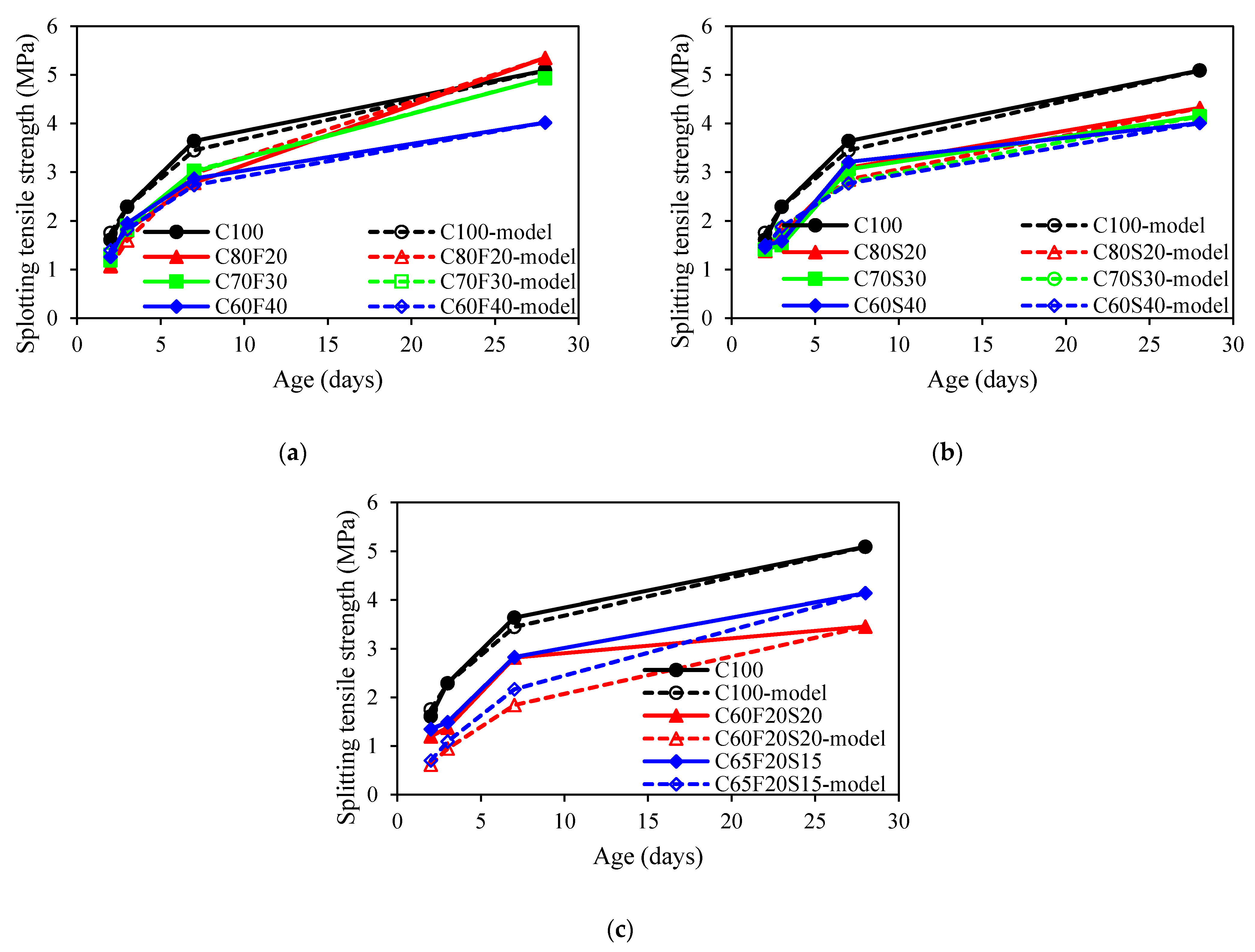
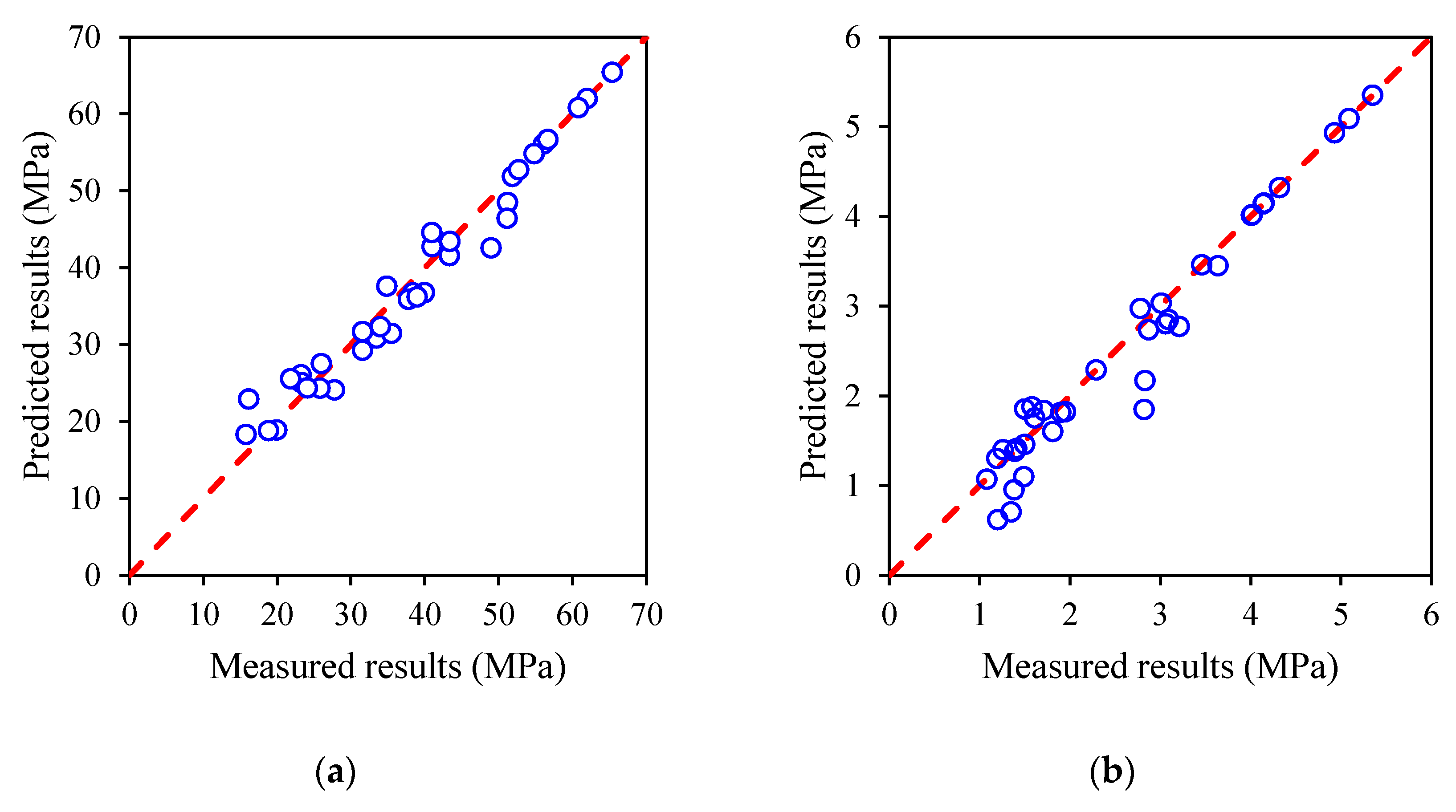
| Chemical Composition | Cement | Fly Ash | GGBFS |
|---|---|---|---|
| CaO | 63.22 | 1.93 | 34.69 |
| MgO | 1.56 | 0.95 | 7.21 |
| Fe2O3 | 3.25 | 4.88 | 1.86 |
| Al2O3 | 3.67 | 33.18 | 15.55 |
| SiO2 | 22.89 | 55.91 | 36.93 |
| SO3 | 2.09 | 0.51 | 0.66 |
| Loss on ignition (LoI) | 2.14 | 0.99 | 2.19 |
| Sample ID | Mix Proportions (kg/m3) | ||||||
|---|---|---|---|---|---|---|---|
| Cement | FA | GGBFS | Coarse Agg 1 | Coarse Agg 2 | Fine Agg | Water | |
| C100 | 400 | 0 | 0 | 439 | 658 | 731.2 | 152 |
| C80F20 | 320 | 80 | 0 | 439 | 658 | 731.2 | 152 |
| C70F30 | 280 | 120 | 0 | 439 | 658 | 731.2 | 152 |
| C60F40 | 240 | 160 | 0 | 439 | 658 | 731.2 | 152 |
| C80S20 | 320 | 0 | 80 | 439 | 658 | 731.2 | 152 |
| C70S30 | 280 | 0 | 120 | 439 | 658 | 731.2 | 152 |
| C60S40 | 240 | 0 | 160 | 439 | 658 | 731.2 | 152 |
| C65F20S15 | 260 | 80 | 60 | 439 | 658 | 731.2 | 152 |
| C60F20S20 | 240 | 80 | 80 | 439 | 658 | 731.2 | 152 |
| C65F35 | 247 | 133 | 0 | 146 | 292 | 780 | 180 |
| C60F25S15 | 228 | 95 | 57 | 146 | 292 | 747 | 152 |
| C65F15S20 | 292 | 68 | 90 | 146 | 292 | 778 | 155 |
| Sample ID | 7d | 28d |
|---|---|---|
| C100 | 40.37 | 53.82 |
| C80F20 | 43.01 | N/A |
| C70F30 | 40.29 | 50.67 |
| C80S20 | 42.33 | 45.62 |
| C60S40 | 40.97 | 51.12 |
| C65F20S15 | N/A | 45.77 |
| C60F20S20 | 32.68 | 51.09 |
| Sample ID | |||
|---|---|---|---|
| C100 | 0.146 | 0.389 | 0.288 |
| C80F20 | 0.152 | 0.582 | N/A |
| C70F30 | 0.309 | 0.49 | 0.229 |
| C60F40 | 0.382 | 0.377 | N/A |
| C80S20 | 0.332 | 0.41 | 0.075 |
| C70S30 | 0.337 | 0.41 | N/A |
| C60S40 | 0.357 | 0.363 | 0.221 |
| C65F20S15 | 0.339 | 0.434 | N/A |
| C60F20S20 | 0.363 | 0.368 | 0.447 |
Publisher’s Note: MDPI stays neutral with regard to jurisdictional claims in published maps and institutional affiliations. |
© 2022 by the authors. Licensee MDPI, Basel, Switzerland. This article is an open access article distributed under the terms and conditions of the Creative Commons Attribution (CC BY) license (https://creativecommons.org/licenses/by/4.0/).
Share and Cite
Qu, Z.; Liu, Z.; Si, R.; Zhang, Y. Effect of Various Fly Ash and Ground Granulated Blast Furnace Slag Content on Concrete Properties: Experiments and Modelling. Materials 2022, 15, 3016. https://doi.org/10.3390/ma15093016
Qu Z, Liu Z, Si R, Zhang Y. Effect of Various Fly Ash and Ground Granulated Blast Furnace Slag Content on Concrete Properties: Experiments and Modelling. Materials. 2022; 15(9):3016. https://doi.org/10.3390/ma15093016
Chicago/Turabian StyleQu, Zhiwei, Zihao Liu, Ruizhe Si, and Yingda Zhang. 2022. "Effect of Various Fly Ash and Ground Granulated Blast Furnace Slag Content on Concrete Properties: Experiments and Modelling" Materials 15, no. 9: 3016. https://doi.org/10.3390/ma15093016






